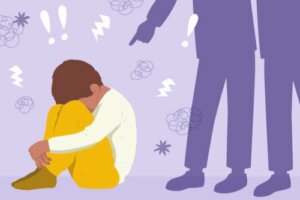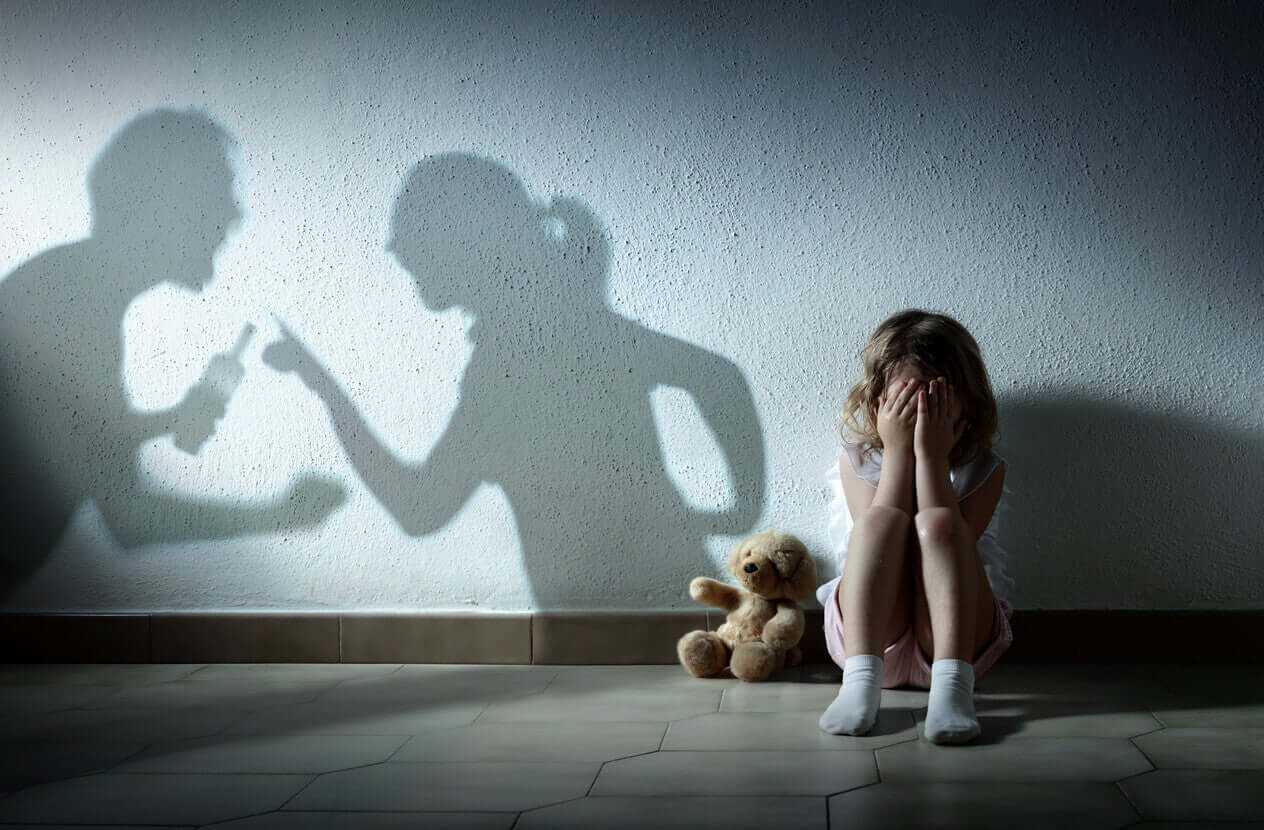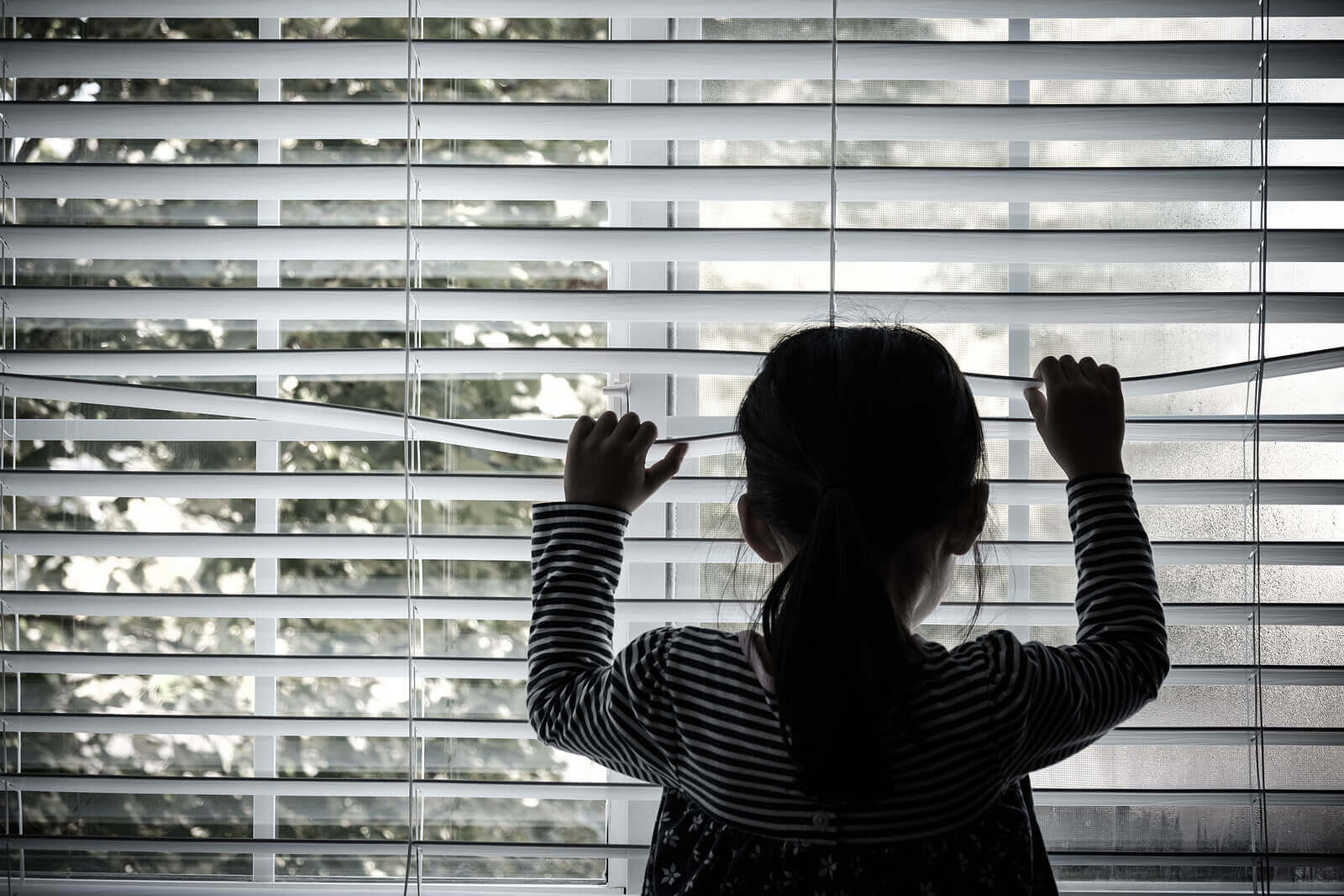How to Detect Psychological Abuse in Children

Psychological abuse in children is more common than many believe. Many times, they’re behaviors disguised as subtlety that hide a certain violence, such as “educational punishments”.
Phenomena like these are found in thousands of homes and spaces where childhoods pass. And in fact, cases of child abuse have increased considerably due to the isolation of the pandemic.
However, there are indicators that allow us to address this problem from prevention and timely intervention. Do you want to learn more about them?
What is child abuse?
Child abuse is any action or omission that may harm the integral development of a child, whether it’s on a physical, psychological, emotional, or social level.
For this reason, abuse can take on various forms, some more visible than others. For example, neglect (inattention, indifference, neglect of a personas needs and demands), exploitation, abuse (sexual, psychological or physical), and the induction of illness or the invention of said condition in the minor.
According to different investigations, there are different risk factors that increase the possibility of children being abused. Among them, the following stand out:
- Environmental factors: Economic instability, family isolation, parental unemployment.
- Factors related to their parents: Problematic substance use, personal history of abuse in childhood, ignorance about child development, authoritarian parenting styles, adolescent parents.
- Characteristics of the child: Health conditions that imply greater vulnerability or require great care, such as a chronic disease or a developmental disorder.
It’s important to note that the presence of a risk factor doesn’t necessarily imply that there’s child abuse. But the combination of these elements favor the appearance of this condition in the home.
Finally, it’s worth mentioning that child psychological abuse doesn’t only occur within the family, but also in institutional settings.

Types of child abuse
There are different types of child abuse: Physical abuse, sexual abuse, neglect, and psychological or emotional abuse.
Regarding psychological abuse, it meets a series of requirements such as those mentioned below:
- The child receives insults and threats frequently.
- They’re frightened or threatened into carrying out certain actions even against their will.
- They often receive physical or psychological punishments.
- The child remains in isolation.
- They lack opportunities or possibilities to develop, grow, and achieve a state of well-being.
- They receive humiliations for their appearance, their personality, the things they do, or the things they don’t do.
- He or she is ridiculed or pejoratively branded.
- They experience the indifference or implicit or explicit rejection of their caregivers.
- They witness abuse or violence between their parents.
It may interest you: Child Abuse: What Is It and What Are Its Effects?
Indicators of child psychological abuse
Child abuse can be detected in different ways, although the most obvious way is by observing the child’s behavior. Therefore, when changes occur abruptly, for no apparent reason, they should attract our attention.
Some of the indicators that account for the presence of psychological abuse in children are the following:
- Permanent anxiety and nervousness
- Excessive shyness
- Discomfort in the presence of other adults
- Sadness, discouragement, laziness, little interest in activities
- Aggression, anger, excessive angry reactions with their peers
- Difficulties related to sleep
- Regression of certain behaviors from previous stages
- Eating problems
- Changes in school performance
Of course, these indicators aren’t exclusive to abuse, but can be symptoms of other health conditions. Therefore, it’s important to spend time with the child in order to identify what’s happening to them.
In turn, professional consultation can be useful to make the differential diagnosis and identify the possible cause of their behavior or discomfort.
Consequences of psychological abuse in children
The consequences of psychological abuse in children are severe in all aspects of children’s lives, as the damage occurs at a stage when children are still developing.
However, its greater or lesser severity depends on certain individual factors, such as the child’s age, the type of abuse, and its chronicity.
Some of the most notorious consequences are expressed in the following spheres of the infant:
- Cognitive: Manifested through learning difficulties.
- Psychological: These consequences come to light as behavioral problems, difficulties with self-regulation, or signs of low self-esteem.
- Organic: Lesions appear in the brain that can affect the neurodevelopment of the child.
So what can we do to prevent psychological abuse of children?
To treat our children well, we must show them affection and availability. Likewise, we must provide them with varied learning experiences, be attentive to their needs, listen to them, and provide them with basic care (food, education, and housing).
These are some of the measures that can lead to a protected childhood and well-being.
It may interest you: Why You Shouldn’t Bully Your Kids
Abuse doesn’t happen overnight

Many times, it’s thought that the abuse is limited to the moment in which the child receives a hit, but the signs appear sooner. In general, it tends to present itself in more subtle ways, but these are equally damaging and painful.
It’s important not to normalize certain parental behaviors under the idea that “it’s for their own good”, “it teaches them a lesson about life” or “it keeps kids from being spoiled”.
These ideas, far from promoting healthy relationships and bonds of trust, teach infants that they should be on constant alert and protect themselves from people. In fact, many of those children will be the ones who later exert violence or bullying against their peers.
So, you have to pay attention to these signs and question your own ideas. You can even evaluate your own childhood so as not to confuse discipline and limits with violence and abuse.
Psychological abuse in children is more common than many believe. Many times, they’re behaviors disguised as subtlety that hide a certain violence, such as “educational punishments”.
Phenomena like these are found in thousands of homes and spaces where childhoods pass. And in fact, cases of child abuse have increased considerably due to the isolation of the pandemic.
However, there are indicators that allow us to address this problem from prevention and timely intervention. Do you want to learn more about them?
What is child abuse?
Child abuse is any action or omission that may harm the integral development of a child, whether it’s on a physical, psychological, emotional, or social level.
For this reason, abuse can take on various forms, some more visible than others. For example, neglect (inattention, indifference, neglect of a personas needs and demands), exploitation, abuse (sexual, psychological or physical), and the induction of illness or the invention of said condition in the minor.
According to different investigations, there are different risk factors that increase the possibility of children being abused. Among them, the following stand out:
- Environmental factors: Economic instability, family isolation, parental unemployment.
- Factors related to their parents: Problematic substance use, personal history of abuse in childhood, ignorance about child development, authoritarian parenting styles, adolescent parents.
- Characteristics of the child: Health conditions that imply greater vulnerability or require great care, such as a chronic disease or a developmental disorder.
It’s important to note that the presence of a risk factor doesn’t necessarily imply that there’s child abuse. But the combination of these elements favor the appearance of this condition in the home.
Finally, it’s worth mentioning that child psychological abuse doesn’t only occur within the family, but also in institutional settings.

Types of child abuse
There are different types of child abuse: Physical abuse, sexual abuse, neglect, and psychological or emotional abuse.
Regarding psychological abuse, it meets a series of requirements such as those mentioned below:
- The child receives insults and threats frequently.
- They’re frightened or threatened into carrying out certain actions even against their will.
- They often receive physical or psychological punishments.
- The child remains in isolation.
- They lack opportunities or possibilities to develop, grow, and achieve a state of well-being.
- They receive humiliations for their appearance, their personality, the things they do, or the things they don’t do.
- He or she is ridiculed or pejoratively branded.
- They experience the indifference or implicit or explicit rejection of their caregivers.
- They witness abuse or violence between their parents.
It may interest you: Child Abuse: What Is It and What Are Its Effects?
Indicators of child psychological abuse
Child abuse can be detected in different ways, although the most obvious way is by observing the child’s behavior. Therefore, when changes occur abruptly, for no apparent reason, they should attract our attention.
Some of the indicators that account for the presence of psychological abuse in children are the following:
- Permanent anxiety and nervousness
- Excessive shyness
- Discomfort in the presence of other adults
- Sadness, discouragement, laziness, little interest in activities
- Aggression, anger, excessive angry reactions with their peers
- Difficulties related to sleep
- Regression of certain behaviors from previous stages
- Eating problems
- Changes in school performance
Of course, these indicators aren’t exclusive to abuse, but can be symptoms of other health conditions. Therefore, it’s important to spend time with the child in order to identify what’s happening to them.
In turn, professional consultation can be useful to make the differential diagnosis and identify the possible cause of their behavior or discomfort.
Consequences of psychological abuse in children
The consequences of psychological abuse in children are severe in all aspects of children’s lives, as the damage occurs at a stage when children are still developing.
However, its greater or lesser severity depends on certain individual factors, such as the child’s age, the type of abuse, and its chronicity.
Some of the most notorious consequences are expressed in the following spheres of the infant:
- Cognitive: Manifested through learning difficulties.
- Psychological: These consequences come to light as behavioral problems, difficulties with self-regulation, or signs of low self-esteem.
- Organic: Lesions appear in the brain that can affect the neurodevelopment of the child.
So what can we do to prevent psychological abuse of children?
To treat our children well, we must show them affection and availability. Likewise, we must provide them with varied learning experiences, be attentive to their needs, listen to them, and provide them with basic care (food, education, and housing).
These are some of the measures that can lead to a protected childhood and well-being.
It may interest you: Why You Shouldn’t Bully Your Kids
Abuse doesn’t happen overnight

Many times, it’s thought that the abuse is limited to the moment in which the child receives a hit, but the signs appear sooner. In general, it tends to present itself in more subtle ways, but these are equally damaging and painful.
It’s important not to normalize certain parental behaviors under the idea that “it’s for their own good”, “it teaches them a lesson about life” or “it keeps kids from being spoiled”.
These ideas, far from promoting healthy relationships and bonds of trust, teach infants that they should be on constant alert and protect themselves from people. In fact, many of those children will be the ones who later exert violence or bullying against their peers.
So, you have to pay attention to these signs and question your own ideas. You can even evaluate your own childhood so as not to confuse discipline and limits with violence and abuse.
All cited sources were thoroughly reviewed by our team to ensure their quality, reliability, currency, and validity. The bibliography of this article was considered reliable and of academic or scientific accuracy.
- Palacios, J., Moreno, M. C., & Jiménez, J. (1995). El maltrato infantil: concepto, tipos, etiología. Infancia y aprendizaje, 18(71), 7-21. Disponible en: https://www.redalyc.org/pdf/292/29211205.pdf
- Aparicio, A. M. (2008). Hacia un sistema de clasificación nosológico de maltrato infantil. Anales de Psicología/Annals of Psychology, 24(1), 77-87. Disponible en: https://revistas.um.es/analesps/article/view/31801
- Forero LCA, Araújo Reyes AP, Godoy Díaz AP, Vera Rueda ME. (2010). Maltrato infantil y sus consecuencias a largo plazo. MedUNAB [Internet]. 13(2):103-15. Disponible en: https://revistas.unab.edu.co/index.php/medunab/article/view/1155
This text is provided for informational purposes only and does not replace consultation with a professional. If in doubt, consult your specialist.








